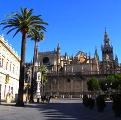
A (very brief) Guide to Seville
Seville, the capital of the Spanish community of Andalusia, is one of the oldest cities in Europe. Its architecture is a reflection of its tumultuous history with long spells of occupation by the Romans and later the Moors.
In the 16th century, after the reconquista by the Christians the city reached its Golden Age thanks to a monopoly on trade with the New World. Many of the city’s magnificent landmarks such as the Cathedral, the Royal Alcazar and Golden Tower were built earlier, in the 13th and 14th centuries.
Predominant Architecture:
Islamic, Gothic, Renaissance and Baroque elements can be found in Seville’s buildings, but the most notable Architectural style is perhaps the Mudejar.
Places to See:
Cathedral: Seville’s magnificent cathedral, built in the 15th century, is one of the largest in the world. The gothic interior of the church and the huge gilded altarpiece are simply breathtaking.
Golden Tower: The Torre del Oro was built in the early 13th century as a watchtower by the Almohades, who at the time ruled the region. The tower is now home to a naval museum.
Plaza Virgen de los Reyes: A historic square surrounded by historic buildings. It is dominated by the famous bell tower of Seville’s Cathedral, the Giralda.
Real Alcazar: The Royal Palace of Seville, a magnificent complex of patios and halls in different architectural styles, from Mudéjar to Gothic. The heart of the complex is the Palace of King Pedro I, who constructed his royal residence in 1364 at the site of a Moorish palace.
Plaza de Espana: A majestic architectural complex built as the central office for the Ibero-American Exposition, a world fair held in Seville in 1929.
La Giralda: The bell tower of the Cathedral is the most famous landmark in Seville. The tower was originally built at the end of the 12th century as the minaret of a large mosque built by the Moors.